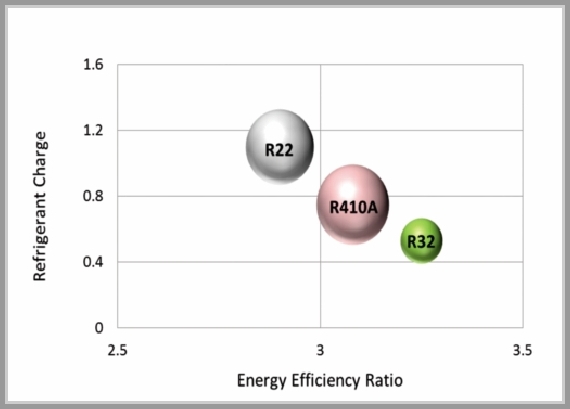The next stage of refrigerant phase-out/phase-down
Refrigerants have been an environmental issue for many years. Having dealt with CFCs and HFCs, the pressure now moves on to HCFCs, with R32 being seen as solution. Ken Sharpe reports.
Almost as soon as the use of R22 for maintaining air-conditioning systems came to an end in the EU does the phasing out/down of HFC refrigerants start. R22 is an HCFC, meaning that it contains ozone-depleting chlorine. The ozone-depletion potential of R22 is only a twentieth of refrigerants such as R11 and R12, which were phased out many years ago, but phased out it now has been.
The depletion of the ozone layer over Antarctica having been addressed, it became apparent that refrigerants present another environmental hazard by virtue of their global-warming potential (GWP), which can be hundreds or, even, thousands of times greater than that of carbon dioxide, which is regarded as having a GWP of 1.
The fact that refrigerants are meant to stay safely locked inside a system and that their global-warming potential of carbon dioxide emitted from power stations far outweighs the effect of leaks seems to account for little. It is possible that a refrigerant with a low GWP in itself will be responsible for more carbon dioxide entering the atmosphere than one with a higher GWP.
There are two approaches to the future control of refrigerants in the EU. Those with a GWP over 2500, such as R404A, will be phased out. Those with a GWP below 2500, such as R410A, will be phased down. The process starts in 2015 and continues until 2030, by when an 80% phase-out/phase-down is targeted to be achieved.
The future approach to regulations for refrigerants is based on the GWP of the refrigerant charge — i.e. the GWP of the refrigerant compared to carbon dioxide multiplied by the charge. Systems with a low-GWP refrigerant can therefore have a larger charge than those with a higher GWP.
R410A is a 50/50 mixture of R125 and R32. However, R410A has a GWP of 2088, compared to just 675 for R32. Daikin’s approach is to replace R410A with R32, along with a number of other companies.
However, R32 is slightly flammable, but according to Graham Wright, legislation specialist with Daikin UK, is ‘acceptability safe in many applications.
R32 offers many benefits on the road to reducing the use of HFCs, as Daikin explains in a session it has prepared to train installers.
The lower GWP of R32 compared with R410A is explained by comparing a the effect of a charge.

• 10 kg of R410A is equivalent to 20.88 t of CO2
• 10kg of R32 is equivalent to just 6.75 t of CO2
Comparing like charges is only part of the story, because R32 is more efficient as a refrigerant than R410A.
Graham Wright’s comparison is that 0.7 kg of R32 in a 3 kW split system has an equivalent performance to 1 kg of R410A. The overall effect on total CO2 equivalence is huge. That 0.3 kg reduction in charge give a 71% difference in total CO2 equivalence — remember that 80% target by 2030.
From performance and environmental viewpoints, R32 ticks the right boxes. But what about safety issues?
The standards to be concerned with are ISO 5149, ISO 817 and EN 378. R32 is classed as a ‘Class 2: lower flammability refrigerant’. It is also not toxic, with no toxicity having been identified at concentrations of 400 ppm or less. A point of detail is that the 30% reduction in charge enables systems to be larger without 400 ppm being exceeded in the air in a room if the refrigerant charge is lost within the building or a room in a hotel.
As might be expected from a Japanese company, R32 systems have already been extensively installed in Japan — over 4 million units — and they are now available in Europe.







